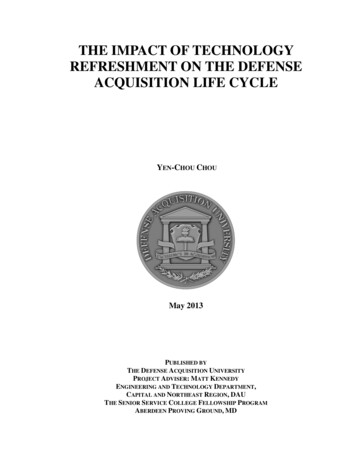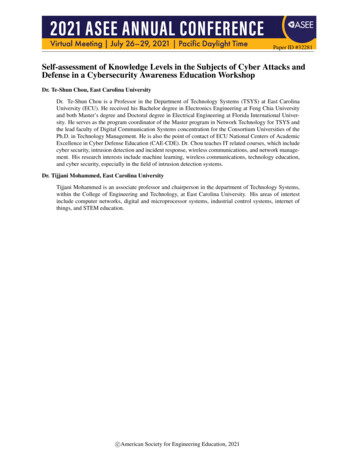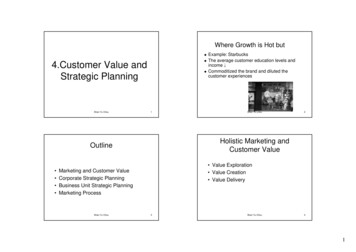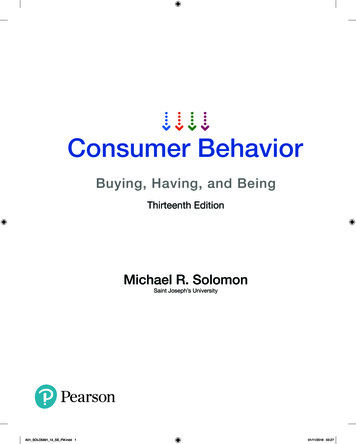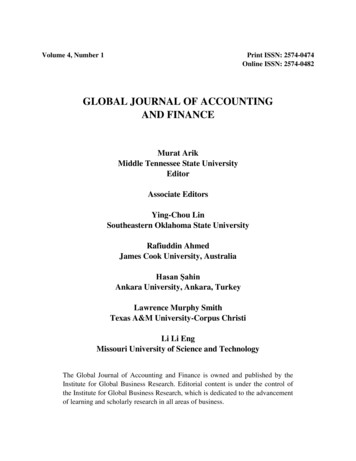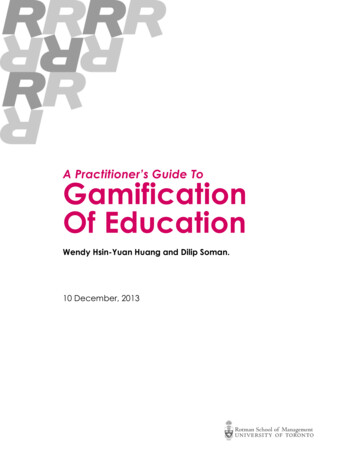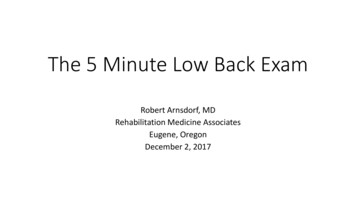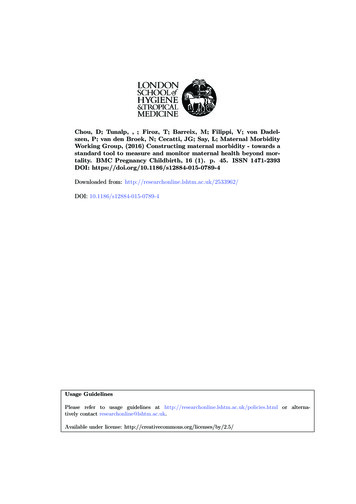
Transcription
Chou, D; Tunalp, , ; Firoz, T; Barreix, M; Filippi, V; von Dadelszen, P; van den Broek, N; Cecatti, JG; Say, L; Maternal MorbidityWorking Group, (2016) Constructing maternal morbidity - towards astandard tool to measure and monitor maternal health beyond mortality. BMC Pregnancy Childbirth, 16 (1). p. 45. ISSN 1471-2393DOI: d from: http://researchonline.lshtm.ac.uk/2533962/DOI: 10.1186/s12884-015-0789-4Usage GuidelinesPlease refer to usage guidelines at http://researchonline.lshtm.ac.uk/policies.html or alternatively contact researchonline@lshtm.ac.uk.Available under license: http://creativecommons.org/licenses/by/2.5/
Chou et al. BMC Pregnancy and Childbirth (2016) 16:45DOI 10.1186/s12884-015-0789-4DEBATEOpen AccessConstructing maternal morbidity – towardsa standard tool to measure and monitormaternal health beyond mortalityDoris Chou1*, Özge Tunçalp1, Tabassum Firoz2, Maria Barreix1, Veronique Filippi3, Peter von Dadelszen4,Nynke van den Broek5, Jose Guilherme Cecatti6, and Lale Say1 on behalf of the Maternal Morbidity Working GroupAbstractBackground: Maternal morbidity is a complex entity and its presentation and severity are on a spectrum. Thispaper describes the conceptualization and development of a definition for maternal morbidity, and the frameworkfor its measurement: the maternal morbidity matrix, which is the foundation for measuring maternal morbidity,thus, the assessment tool.Discussion: We define maternal morbidity and associated disability as “any health condition attributed to and/orcomplicating pregnancy and childbirth that has a negative impact on the woman’s wellbeing and/or functioning.” Amatrix of 121 conditions was generated through expert meetings, review of the International Classification ofDiseases and related health problems (ICD-10), literature reviews, applying the definition of maternal morbidity anda cut-off of 0.1 % prevalence. This matrix has three dimensions: identified morbidity category, reportedfunctioning impact and maternal history. The identification criteria for morbidity include 58 symptoms, 29 signs, 44investigations and 35 management strategies; these criteria are aimed at recognizing the medical condition, or thefunctional impact/disability component that will capture the negative impact experienced by the woman.Summary: The maternal morbidity matrix is a practical framework for assessing maternal morbidity beyond nearmiss. In light of the emerging attention to Universal Health Coverage (UHC) as part of the post-2015 SustainableDevelopment Goals (SDGs) planning, a definition and standard identification criteria are essential to measuring itsextent and impact.Keywords: Maternal morbidity, Definition, Measurement, Sustainable Development Goals (SDGs)BackgroundImproving maternal health and reducing related mortality have been key concerns of the international community as one of the eight Millennium Development Goals(MDG 5) [1]. However, maternal mortality accounts foronly a small fraction of the overall burden of poor maternal health. Maternal morbidity – the health problemsborne by women during pregnancy, childbirth and thepostpartum period contribute to this burden. Yet, thetrue extent of maternal morbidity is unknown. It has* Correspondence: choud@who.int1UNDP/UNFPA/UNICEF/WHO/World Bank Special Programme of Research,Development and Research Training in Human Reproduction (HRP),Department of Reproductive Health and Research, World HealthOrganization, Geneva, SwitzerlandFull list of author information is available at the end of the articlebeen suggested that for each maternal death, 20 or 30women suffer from morbidity; however, these calculations are not based on standard, well documented, andtransparent methodologies [2, 3]. Overall, three major issues have limited valid, routine, and comparable measurements of maternal morbidity, the lack of a commondefinition and identification criteria, standardized assessment tools especially at primary health care level, andcommon indicators to measure morbidity [2]. Developing measurement criteria for the burden of pregnancyand post-partum related morbidity is crucial to the ongoing elaboration of the post-2015 Sustainable Development Goals (SDGs) in light of required attention tomorbidity as maternal deaths have dropped significantlyover the past two decades [4]. 2016 Chou et al. Open Access This article is distributed under the terms of the Creative Commons Attribution 4.0International License (http://creativecommons.org/licenses/by/4.0/), which permits unrestricted use, distribution, andreproduction in any medium, provided you give appropriate credit to the original author(s) and the source, provide a link tothe Creative Commons license, and indicate if changes were made. The Creative Commons Public Domain Dedication o/1.0/) applies to the data made available in this article, unless otherwise stated.
Chou et al. BMC Pregnancy and Childbirth (2016) 16:45In 2011, the World Health Organization (WHO) developed a common definition and identification criteriafor very severe cases of maternal morbidity (maternalnear-miss) allowing its routine measurement and monitoring, especially as a tool for assessment of the qualityof care women with severe morbidity receive [5]. Suchdefinition and criteria do not exist for less-severe casesalong the continuum of maternal ill health. It is necessary to arrive at a common definition and to establishclear criteria for accurate and routine measurement ofmaternal morbidity in order to inform policy decisions,resource allocation and ultimately to launch an appropriate programmatic response that will also help in reducing maternal deaths, and long-term suffering anddisability. This is particularly essential at the communityand primary care levels, where most of the burden ofmaternal morbidity is believed to be reported [6, 7], yetinstruments to quantify and measure it are currentlylacking [2].To fulfill the need to measure and respond to the fullburden of maternal morbidity, WHO initiated a project,funded by the Bill and Melinda Gates Foundation, to improve the scientific basis for defining, measuring andmonitoring maternal morbidity. This project aims toconstruct a definition and develop identification criteriafor maternal morbidity, estimate the burden of individual causes or determining factors of maternal morbiditybased on existing evidence, develop and test an assessment tool for measuring maternal morbidity in low- andmiddle-income countries, and develop indicators for maternal morbidity.The project is led and carried out by a technical working group, the Maternal Morbidity Working Group(MMWG), composed of obstetricians, physicians, midwives, epidemiologists, medical anthropologists, publichealth professionals and patient advocates from high-,middle- and low-income countries [2]. The WHOMMWG was initially convened in April 2012. Participants were invited to join the working group based upontheir known technical expertise in quantitative andqualitative maternal health research, maternal healthprograms, contributions to other related research initiatives or membership on WHO technical advisory groupsor with potential links to this work, consumer perspective, and to ensure regional and gender balance. Wherethis paper reports decisions by the MMWG, thesewere made by consensus discussions during five WGmeetings (April and August 2012, February 2013,February and October 2014) as well as interim electronic communication.Since 2012, the MMWG has elaborated on maternalmorbidity from different perspectives, and on the basisof existing evidence has agreed on a common frameworkfor maternal morbidity. This body of work is intended toPage 2 of 10complement the maternal near-miss morbidity concept,whereby together they specify the full continuum ofmaternal morbidity [2]. This work will be incorporated in the 11th revision of the key standards forhealth conditions - the International Statistical Classification of Diseases and related health problems(ICD), further enhancing the sustainability of the outputs [8]. While doing so, publishing the developmentprocess to ensure transparency and encouraging further collaboration from researchers, clinicians, andother stakeholders have been key to the work of theMMWG.The objective of this paper is to describe this concept, and the framework, for identifying and measuring “non-severe” maternal morbidity, and thematernal morbidity matrix (see Figs. 1 2, 3 and 4)which informed the development of a “morbidity”tool, which will be pilot tested for usability, feasibility,and fit for purpose (Please see Table 1 for an outlineof the tool’s components). The "morbidity" tool isconceptualized to measure maternal morbidity in primary health care settings which have high levels ofservice demand [9]. Nonetheless, improved access isnot enough, health services must also be of goodquality [10]. Measuring morbidity can serve as an indicator of the quality of obstetric care [11, 12]. Ideallythe long-term outputs of this project are to establishroutine data collection on maternal morbidity toinform service provision at facility-level.The MMWG deliberated the development of acommunity (non-health care setting) level tool to capture women who do not have regular access to medical services; however, given the time and resourceconstraints as well as consideration of prior researchwhich found that women’s recall of complications haslow specificity and would necessitate observation by atrained health or community worker [13, 14] theGroup chose to focus its efforts on the primary facility/lowest facility level point-of-care. We discuss thedevelopment of the concept, the components of thematrix and the theoretical and methodological underpinnings for each.DiscussionConcept of maternal morbidity: rationaleA standard definition for maternal morbidity does notexist nor does the literature report maternal morbiditysystematically in a commonly agreed upon approach [3].On the basis of the background scoping exercise [3], andbuilding upon the WHO definition of health [15] andmaternal mortality [16], the MMWG, by consensus,agreed on the definition for maternal morbidity and associated disability as “any health condition attributed toand/or complicating pregnancy and childbirth that has a
Chou et al. BMC Pregnancy and Childbirth (2016) 16:45Page 3 of 10Fig. 1 Maternal morbidity matrix, Dimension 1: SYMPTOM, SIGN, INVESTIGATIONS & MANAGEMENT (Direct Maternal Morbidity)negative impact on the woman’s wellbeing and/or functioning.” Heretofore, the term ‘maternal morbidity’ refersspecifically to this definition of the concept. This broaddefinition recognizes the impact that morbidity mayhave on different dimensions of health, beyond physicalhealth and seeks to encompass the totality of a woman’s
Chou et al. BMC Pregnancy and Childbirth (2016) 16:45Fig. 2 Maternal morbidity matrix, Dimension 1: SYMPTOM, SIGN, INVESTIGATIONS & MANAGEMENT (Indirect Maternal Morbidity)Page 4 of 10
Chou et al. BMC Pregnancy and Childbirth (2016) 16:45Page 5 of 10Fig. 3 Maternal morbidity matrix, Dimension 2: Functional Impact - International Classification for Functioning and Disability (ICF) codessense of wellbeing. Terminology used in this manuscriptcan be found in Table 2 below.Based on this definition and with the goal of developing identification criteria to be embedded within ameasurement tool for maternal morbidity, we initiallyfocused on formulating and populating a matrix ofconditions, not limited by the obstetrical andgynecological perspective. A number of issues wereidentified by the MMWG to inform the basic premisesof the matrix, which members deemed necessary to include or at least consider for inclusion: 1) obstetricmorbidities, 2) previous/co-existing conditions, 3)mental conditions, 4) intervention related morbidities,5) trauma (i.e. domestic violence), and 6) cultural practices (i.e. female genital mutilation). In order to identify cases of maternal morbidity according to theagreed upon definition and to strike a balance betweenfeasibility and utility in identification of maternal morbidity cases, we adopted a set of guiding principles toproceed with this work:1) identification and measurement of the selectedmaternal conditions should be pragmatic, actionoriented, evidence-based, feasible and applicable todifferent settings, with regional and internationalacceptance;2) maternal morbidity should not be viewed asconsisting only of the conditions themselves, butalso their consequences; and3) morbid conditions should be prioritized on the basisof their frequency and impact. In addition, we mayfocus on under- researched and neglected areas.Balancing the tension between goals of being comprehensive and complete with usability and feasibilityproved to be a challenge considering issues such asregional differences in disease incidence and prevalence, the spectrum of maternal morbidity, its occurrence, severity, duration, impact and how a morbidityaffects the woman’s well-being. To focus on “what tomeasure”, we considered the role of prevalence andimpact, while recognizing the need to better understand under-researched or neglected areas and theneed to define what is intended by the qualifiers of“attributed to” or “complicating”. On “how to measure” maternal morbidity, we envisioned the development of a core module applicable to primary caresettings. In either instance, the condition should beassociated with a negative maternal outcome. We specified that the particular areas of interest would bethe complications and/or manifestations of these conditions either during pregnancy or postpartum.
Chou et al. BMC Pregnancy and Childbirth (2016) 16:45Page 6 of 10Fig. 4 Maternal morbidity matrix, Dimension 3: Maternal HistoryMaternal morbidity matrix: foundations of ameasurement toolTo devise identification criteria we considered categorization of different markers anatomically or by system, aswas done in the development of maternal near-miss concept. However, given the particularities of less-severeTable 1 Maternal morbidity draft tool componentsSection 1: Personal historySocial and demographic informationObstetric history ( focusing on current/most recent pregnancy)Sexual HealthRisk-factors/environmentSection 2: SymptomsDisability and functioning WHO Disability AssessmentSchedule 2.0 (12-item version)General symptomsMental health Generalized Anxiety Disorders-7 Personal Health Questionnaire 9Section 3: SignsGeneral physical examLaboratory tests and resultspregnancy related complications, a more holisticapproach was favored. Unlike maternal near-missevents, which have by definition very specific clinical,laboratory and management markers, it was understood that such markers might not be sufficientenough to identify maternal morbidity [5, 11]. Assuch, the maternal morbidity matrix consists of threedimensions (Figs. 1 2, 3 and 4).Similar to the near-miss criteria, we sought to develop a set of locally relevant criteria which allow forcomparisons between different settings, regions andcountries. Therefore, the first dimension consists of thesymptoms, signs, investigations and management strategies. Unlike near-miss, symptoms are included in theidentification criteria of maternal morbidity, with theanticipation that they would correlate strongly with theassociated disability (e.g. fatigue, shortness of breath)and thus, may be the primary reason for women to seekcare. Signs are findings on physical examination andare similar to the clinical criteria of the near-misscriteria. The identification criteria also include investigations, which are broader in scope than the labmarkers for the near-miss criteria, and are comprised
Chou et al. BMC Pregnancy and Childbirth (2016) 16:45Page 7 of 10Table 2 DefinitionsTermDefinitionMaternal DeathThe death of a woman while pregnant or within 42 days of termination of pregnancy, irrespective of the durationand the site of the pregnancy, from any cause related to or aggravated by the pregnancy or its management, butnot from accidental or incidental causes [17]Maternal Near-MissA woman who nearly died but survived a complication a complication that occurred during pregnancy, childbirthor within 42 days of termination of pregnancy [11]. Signs of organ dysfunction that follow life-threateningconditions are used to identify maternal near-misses and a set of near-miss indicators enables assessments of thequality of care provided to pregnant women [5].Maternal morbidity andassociated disabilityAny health condition attributed to and/or complicating pregnancy and childbirth that has a negative impact onwoman’s wellbeing and/or functioning.FunctioningIs an umbrella term for body functions, structures, activities and participation. It denotes the negative aspects ofthe interaction between an individual (with a health condition) and that individual’s contextual factors(environmental and personal factors) [29].DisabilityIs an umbrella term for impairments, activity limitations and participation restrictions. It denotes the negativeaspects of the interaction between an individual (with a health condition) and that individual’s contextual factors(environmental and personal factors) [29].of laboratory tests, imaging studies and diagnostic testssuch as biopsies. Management strategies include treatment options like medications, surgical procedures andradiation.Initially, the Group aimed to make the matrix as comprehensive as possible, representing both developing anddeveloped country settings. Informed by the WHOscoping exercise on maternal morbidity [3], reviews ofpublished literature, relevant textbooks and the WHOApplication of ICD-10 to deaths during pregnancy,childbirth and the puerperium: ICD-Maternal Mortality(ICD-MM) [17], a set of conditions were selected. Weconsidered conditions that may occur in women of reproductive age including those specific to pregnancy andpostpartum. A matrix was developed, including each ofthese conditions and their relevant symptoms, signs, investigations and management strategies. The first version included 301 conditions, originally cross-referencedwith 109 symptoms, 106 signs, 121 clinical tests and 91management strategies [2]. At this point, the MMWGrecognized the existing health care structures in lowand middle-income countries (LMICs) to balance aspirational versus pragmatic approaches. Therefore, to further consolidate the matrix, the Group developed andagreed up the following criteria:1) conditions associated with a negative maternaloutcome that are either exclusive to pregnancy,childbirth, and the postpartum state, with anestimated occurrence of 0.1 % in pregnancy; or2) conditions that are not exclusive to pregnancy,childbirth, and postpartum but which occur morefrequently during pregnancy (i.e. pregnancy is a riskfactor for the disease).The cut-off of 0.1 % for occurrence (prevalence or incidence) was deemed to be a reasonable cut-off thatdistinguished between very rare diseases and diseasesthat are more common and was informed by current estimates of disease conditions in the published literature.When evidence was unavailable, the group used a consensus mechanism based on expert opinion. Additionally, to account for regional differences in prevalence ofcertain conditions, the Group intends for the tool, basedon the matrix, to be revised for regional implementation.Moreover, to frame the matrix we used the precedentof ICD-MM, a special adaption of the ICD-10 intendedto improve the classification of maternal mortality andmorbidity [11, 17]. We grouped the domains in line withthe ICD-MM, such as pregnancies with abortive outcome, obstetric hemorrhage or non-obstetric complications, with the intent of showing how data at differentlevels of detail may be aggregated together and to ensurecontinuity between the spectrum of morbidity throughmortality [17]. Additionally, though it is beyond thescope of this work to revisit the definition of “direct”and “indirect” maternal mortality (and by extension,morbidity); the work of this group in reviewing the conditions aligned to each category has been informing thediscussion on whether the distinction between “direct” and“indirect” remain necessary or useful. As a result of theabovementioned process, the next version of the matrix includes 121 conditions cross-referenced with all identifiedcriteria based on the ICD-MM groupings and generated 58symptoms, 29 signs, 44 investigations and 35 managementstrategies. Conditions consistent with severe maternal morbidity as manifestations of maternal near-miss were not included in this consolidated matrix as they are alreadyidentified by the maternal near-miss tool [11].A second dimension is the functional impact and disability assessing the loss of physical, psychological, cognitive, social and economic functions. Key conceptsrelated to functioning and disability as conceptualizedand defined in the International Classification of
Chou et al. BMC Pregnancy and Childbirth (2016) 16:45Functioning, Disability and Health (ICF) are incorporated [11] thru the existing, validated tool, WHO Disability Assessment Schedule 2.0 (WHODAS 2.0) [18].This tool covers 6 domains in line with ICF (cognition,mobility, self-care, getting along, life activities and participation) and produces standardized disability levelsand profiles using a short, simple and easy to administerquestionnaire [18]. In addition, preliminary findingsfrom a systematic review on maternal morbidity andquality of life, currently in progress, will be used to refine our assessment tool to be more centered on maternal health to gauge women’s experiences.The third dimension is the maternal history focusing onsocial and health related characteristics, which might helpidentify the maternal morbidity as well as influence therisk and severity of the morbidity. Some examples includesocio-economic determinants, pre-existing conditions,care seeking during the pregnancy, etc. Incorporating maternal demographic characteristics, past obstetric history,history during index pregnancy and fetal outcome allowsfull elaboration of the “woman as a whole”. Inclusion offetal measures in the index pregnancy appraises linkagesbetween maternal morbidity and fetal outcomes, attestingto the irrefutable mother-baby dyad.ConclusionsTime is now: implications and next stepsThis body of work elaborates the first standard globaldefinition and classification of maternal morbidity. Theepidemiology of pregnancy and childbirth reflects changing demographic patterns; the latest global estimates oncauses of maternal deaths demonstrate the increasedrole of indirect conditions in causing maternal deaths[19]. Moreover, as described in the “obstetric transitionmodel”, with declining maternal deaths, the proportionof individuals with morbidities can only be expected torise [20]. Beyond documenting known contributors tothis changing epidemiology, e.g. the increased age atwhich women become pregnant [21] and co-morbiditiessuch as obesity [22], this framework puts the focus onthe women and incorporates the concepts related to disability and functioning.Based on this concept and framework, we are in theprocess of developing and testing a modular set of maternal morbidity assessment tools in three country settings. This tool will have different modules dependingon the time of data collection (antenatal and postnatal).The assessment tools were designed based on the matrixby thorough iterations and expert review. Wheneverpossible, previously validated tools and scales wereemployed and adapted. For example, established sexualdysfunction and mental health scales are employed aspart of the 1st dimension, the WHODAS 12-item version as part of the 2nd dimension and substance abusePage 8 of 10and intimate partner violence scales as part of the 3rddimension [18, 23]. The results of pilot testing will directfurther refinement and development of the maternalmorbidity tool to ascertain the potential need for regional or country level modifications and to determineits utility in identifying morbidities and issues related toimplementation of the tool. Given the paucity of data ondisability from LMICs and poorer resourced areas, theinterpretation of these pilots will be critical. In the future, this framework can inform a probabilistic algorithmlike the Interpreting Severe Acute Maternal Morbidity(InterSAMM) to identify morbidity, which was in turnmodeled after the Interpreting Verbal Autopsy - 4(InterVA-4) to identify cause of death [24–26].By identifying a case of maternal morbidity, either viaan identified morbidity category and/or by documentation of an associated disability, we believe that the datacollected by the assessment tools will have sufficientgranularity and allow for disaggregation to understandwhat is the incidence/prevalence of a particular morbidity category, and what is the incidence/prevalence of theassociated disability according to the women. Bothcount. In this regard, this work also coincides with theongoing revision of the ICD. The theoretical need to“count” morbidities or clinical conditions and thewomen-reported outcomes inform the broader discussion of trying to understand what we measure and why.Such discourse is particularly important as the globalcommunity debates the post-2015, Sustainable Development Goals (SDGs) agenda, with special attention touniversal health coverage (UHC) as an important aspectto improve health and contribute to development ofpopulations [27]. With regard to maternal health post2015 goal and targets, the underlying strategies towardsthe Ending Preventable Maternal Mortality (EPMM) areintended to address the overall health needs of girls andwomen [28]. Articulated within the strategic objectivestowards EPMM is the need “to address all causes of maternal mortality, reproductive and maternal morbidities,and related disabilities” and to ensure UHC for accessingcare [28]. This is based upon the premise that improvedinformation on morbidity and its lasting consequences,is also likely to expose the inter-related nature of pregnancy care to other aspects of the health sector as wellas non-health sectors (e.g. environment, transportation,financing). Its most important contribution will be, however, in enhancing health system response to maternalmorbidity, including strengthening evidence for the determination of packages for UHC, key means to improveaccess to health care and improve health of populations.Development of a standard definition and frameworkfor maternal morbidity is rife with challenges and thematernal morbidity matrix is a practical framework forassessing maternal morbidity beyond near-miss. In light
Chou et al. BMC Pregnancy and Childbirth (2016) 16:45of the emerging attention to UHC as part of the post2015 SDGs planning, a definition and standard identification criteria are essential to measuring its extent andimpact. As the international community looks at the decreases in maternal mortality, there is an urgent tandemneed to define and measure maternal morbidity. Lookingbeyond 2015, this is an investment we cannot afford toignore.AbbreviationsEPMM: Ending Preventable Maternal Mortality; ICD: International StatisticalClassification of Diseases and related health problems; ICD-MM: WHOApplication of ICD-10 to deaths during pregnancy, childbirth and thepuerperium: ICD-Maternal Mortality; ICF: International Classification ofFunctioning, Disability and Health; InterSAMM: Interpreting Severe AcuteMaternal Morbidity; InterVA-4: Interpreting Verbal Autopsy - 4; LMICs: Lowand Middle Income Countries; MDG: Millennium Development Goal;MMWG: Maternal Morbidity Working Group; SDGs: Sustainable DevelopmentGoals; UHC: Universal Health Coverage; WHO: World Health Organization;WHODAS 2.0: WHO Disability Assessment Schedule 2.0.Competing interestsThe author(s) declare that they have no competing interests.Authors’ contributionsLS, DC, and ÖT led the definition and matrix construction process anddeveloped the text. MB supported the development of the text. TF, VF, PvD,NvD, JGC, and the MMWG contributed to the development of themethodology and rationale behind the definition and matrix. All authorsread and approved the final manuscript.Page 9 of 104.5.6.7.8.9.10.11.12.13.14.15.AcknowledgmentsThe project described in this article is funded by the Bill and Melinda GatesFoundation and WHO’s Department of Reproductive Health and Researchthrough the Special Programme of Research, Development and ResearchTraining in Human Reproduction. Other members of the MMWG whocontributed to the authorship of this work include (in alphabetical order):Sara Cottler, Olubukola Fawole, Atf Ghérissi, Gathari Ndirangu Gichuhi, MetinGülmezoglu, Gill Gyte, Michelle Hindin, Anoma Jayathilaka, Marge Koblinsky,Yacouba Kone, Nenad Kostanjsek, Isabelle Lange, Laura A. Magee, ArvindMathur, Affette McCaw-Binns, Mark Morgan, Stephen Munjanja, CihanÖztopcu, Elizabeth Sullivan, Rachel Vanderkruik.Author details1UNDP/UNFPA/UNICEF/WHO/World Bank Special Programme of Research,Development and Research Training in Human Reproduction (HRP),Department of Reproductive Health and Research, World HealthOrganization, Geneva, Switzerland. 2University of British Columbia, Vancouver,Canada. 3St. George’s, University of London, London, UK. 4London School ofHygiene & Tropical Medicine, London, UK. 5Centre for Maternal andNewborn Health, Liverpool School of Tropical Medicine, Liverpool, UK.6UNICAMP, Faculdade de Ciências Médicas, Caixa Postal 603013081-970Campinas, SP, Brazil.Received: 18 March 2015 Accepted: 11 December 201516.17.18.19.20.21.22.23.24.25.References1. Ronsmans C, Graham WJ. Maternal survival 1 - Maternal mortality: who,when, where, and why. Lancet. 2006;368(9542):1189–200. doi:10.1016/S01406736(06)69380-X.2. Firoz T, Chou D, von Dadelszen P, Agrawal P, Vanderkruik R
monitoring maternal morbidity. This project aims to construct a definition and develop identification criteria for maternal morbidity, estimate the burden of individ-ual causes or determining factors of maternal morbidity based on existing evidence, develop and test an assess-ment tool for measuring maternal morbidity in low- and
